
Home
Services
About us
Blog
Contacts
Navigating the Skies with Code: How A‑Bots.com Converts ArduPilot & Mission Planner Mastery into Commercial UAV Success
Commercial UAV Software Landscape & Market Drivers
Technical Pillars: Inside ArduPilot & Mission Planner
A‑Bots.com Value Proposition: Converting Mastery into Client Results
Future Horizons: AI Autonomy, Swarming & Multi‑Domain Operations
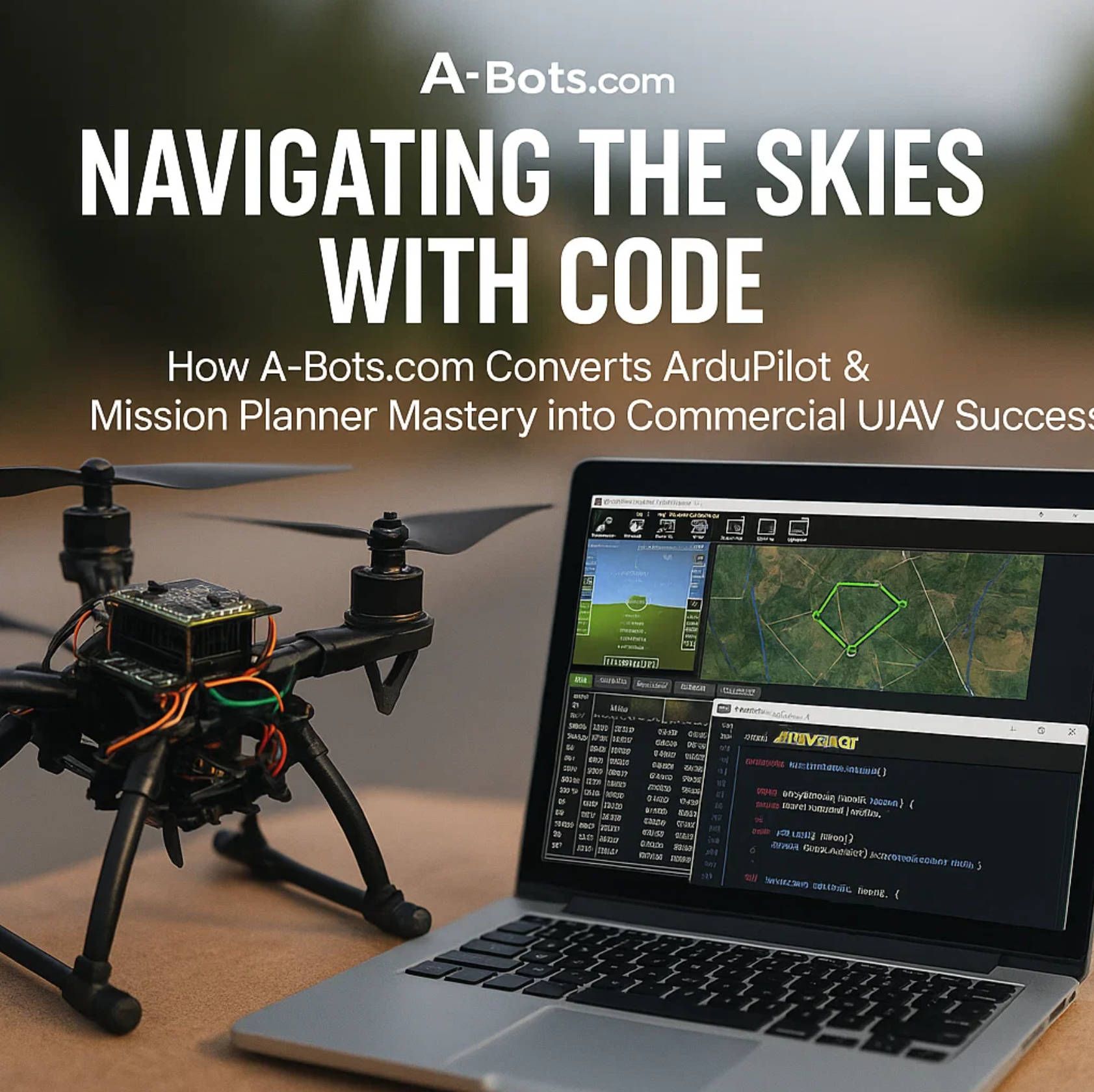
1 Commercial UAV Software Landscape & Market Drivers
1.1 A market moving from hardware to code
When unmanned aircraft first appeared on construction sites and farm fields, value was measured in wingspans and payload ratings. That calculus has flipped. Investors and end‑users now judge a platform by the intelligence that guides it—flight‑control firmware, data‑pipeline orchestration, and the ground‑control stations that translate business logic into airframe behaviour. The money is following that pivot. Independent market research shows the global commercial‑drone sector, worth USD 13.86 billion in 2024, is on track to exceed USD 65 billion by 2032—an annual compound growth of more than 20 percent (fortunebusinessinsights.com). Hardware sales certainly grow with that tide, yet the most aggressive forecasts carve out a disproportionate slice for software and services, because once the airframe is sold the true recurring revenue begins: navigation licenses, autonomy upgrades, data analytics, cloud‑based fleet dashboards.
Three verticals illustrate why this software‑first economy is accelerating. First, precision mapping. Modern agriculture and surveying feed machine‑learning models with centimetre‑grade orthomosaics, forcing drones to fly intricate, high‑density waypoint grids that generic autopilots cannot manage efficiently. Second, industrial inspection. Energy utilities and telecom operators have discovered that replacing rope crews with autonomous cameras halves downtime and slashes insurance exposure, but only if the control stack can fuse multiple sensors, retry in gusty conditions, and log every decision for regulators. Third, public‑safety and logistics. Beyond‑visual‑line‑of‑sight (BVLOS) delivery pilots by national postal services demonstrate that airframe design is the easy part; the hard part is a guidance system capable of dynamic airspace negotiation, redundancy, and remote overrides. These missions are won or lost in code—precisely the layer where open, extensible platforms such as ArduPilot and Mission Planner give system integrators room to innovate.
For equipment manufacturers and enterprise drone operators, the economic signal is clear. Margins once squeezed by commodity airframes are re‑emerging in the software layer. A‑Bots.com entered the market at the right moment: by investing deeply in ArduPilot firmware extensions and Mission Planner plug‑ins, the company can license upgrades to multiple fleets without touching a soldering iron, turning engineering hours into scalable product lines.

1.2 Regulation and the software imperative
If market demand explains why autonomy matters, regulation explains why it must be engineered to higher standards each quarter. The United States set the tone with Part 107, a rule that allowed commercial flights but required waivers for advanced operations such as BVLOS, night missions, or flights over people. Waiver counts have risen every year since adoption, demonstrating both appetite and the paperwork barrier. In 2024 Congress went further, instructing the Federal Aviation Administration to draft a dedicated BVLOS rule—expected as Part 108—so that routine long‑range flights can be authorised without case‑by‑case petitions. Europe’s EASA “specific category” and Canada’s forthcoming BVLOS framework follow the same trajectory: autonomy will be legal, but only when operators prove the reliability of every subsystem, from perception modules to return‑to‑home logic.
That proof is impossible without granular logs, deterministic failsafe states, documented configuration control, and the ability to run entire missions in software‑in‑the‑loop or hardware‑in‑the‑loop simulation before a propeller ever spins. ArduPilot was born in open source and therefore exposes every parameter and internal message for audit, while Mission Planner offers reproducible simulation harnesses and post‑flight analytic dashboards that regulators recognise. This transparency shortens certification cycles; it also allows developers to patch vulnerabilities or tune PID controllers without waiting for a closed‑source vendor.
Regulation, then, is no longer a hurdle but a moat. Enterprises that treat the autopilot as a black box must hire external consultants whenever a rule changes. Those who partner with teams like A‑Bots.com—engineers who can dig into the firmware, adjust heartbeat timing, or script real‑time geofencing—turn compliance into competitive advantage. They step ahead of slower rivals when national air‑navigation services announce remote‑ID mandates or updated detect‑and‑avoid thresholds, because their control stack is already designed for modification.
In this environment, software craftsmanship is both shield and sword: it protects revenue streams from regulatory shock and opens new markets as soon as the law allows. The next sections will explore how ArduPilot’s modular architecture, combined with Mission Planner’s ground‑station versatility, forms the technical foundation A‑Bots.com leverages to deliver that advantage—and why clients who adopt bespoke autopilot code today will dominate the trillion‑dollar drone economy taking shape over the coming decade.
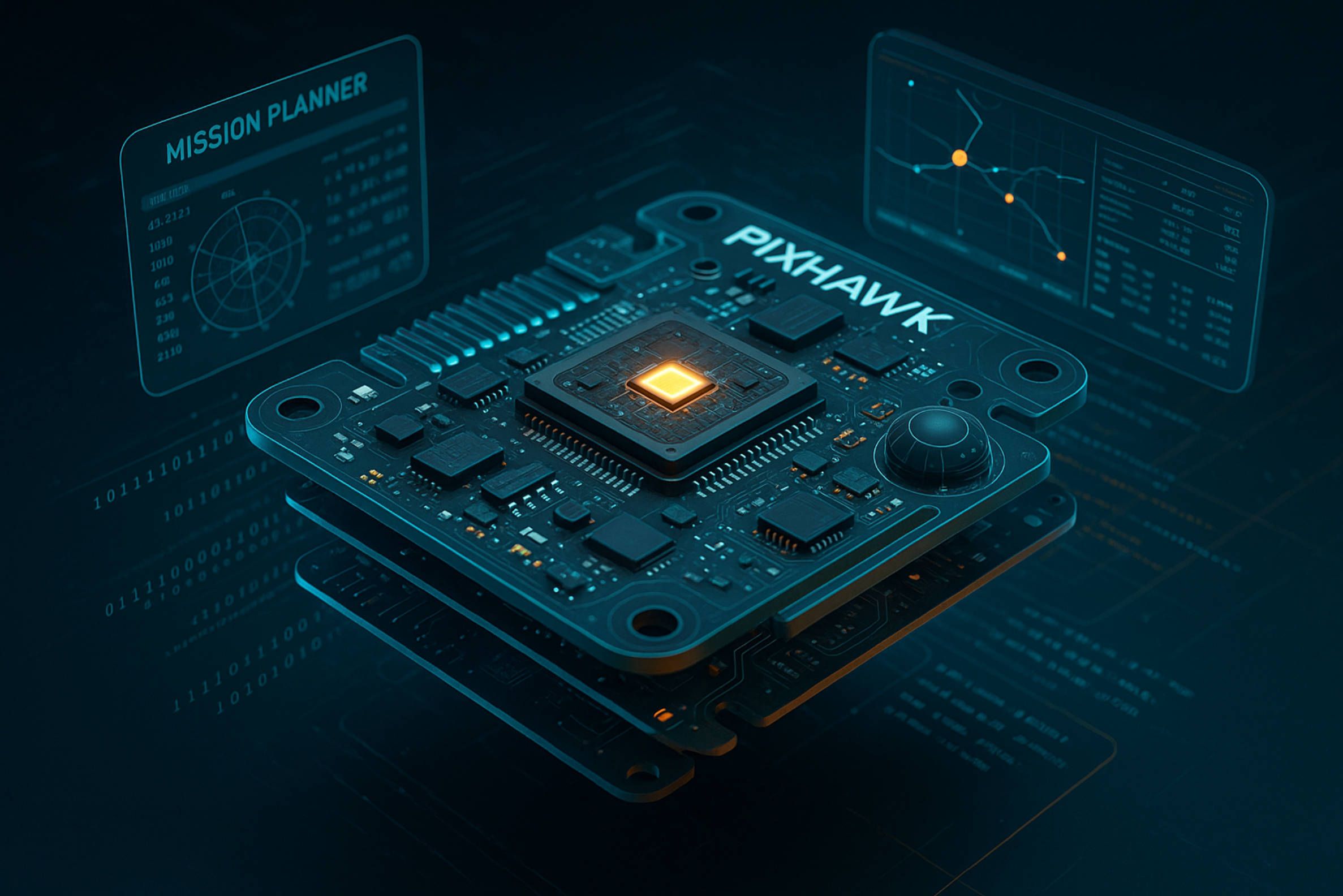
2 Technical Pillars: Inside ArduPilot & Mission Planner
2.1 A single, multi‑domain codebase
ArduPilot began life as an academic autopilot experiment in 2009 and has since grown into the most actively maintained open‑source flight‑control system on the planet. Its GitHub repository lists ≈ 67 600 commits, 12 000 stars and 18 600 forks—a footprint normally associated with enterprise Linux kernels rather than drone firmware GitHub. That depth of contribution signals more than hobby enthusiasm; it means dozens of professional firms, universities and defence labs review every pull request, exposing bugs and edge cases long before a production customer would encounter them.
One practical consequence of that diversity is platform breadth. Instead of maintaining separate code branches for rotorcraft, fixed‑wing aircraft and ground vehicles, ArduPilot houses them under one abstraction layer. The same navigation stack that drives a quad‑plane into a mapping grid can, with parameter changes rather than source edits, steer a rover down a pipeline right‑of‑way or trim a rigid‑wing for maritime patrol. Engineers building fleets therefore start every new concept with a proven scheduler, EKF filter and failsafe matrix. They spend their energy on payload logic or AI perception, not on reinventing attitude controllers for each hull.
For commercial operators the economic upshot is scale: a vendor that supports three vehicle classes by hiring three autopilot teams can, with ArduPilot, redirect that payroll into customer‑facing features while maintaining one common core. A‑Bots.com leverages exactly this synergy, offering clients a “family plan” in which a mapping copter, a surface vessel and an amphibious rover share firmware, ground station and log‑analysis tooling—all delivered under a single maintenance agreement.
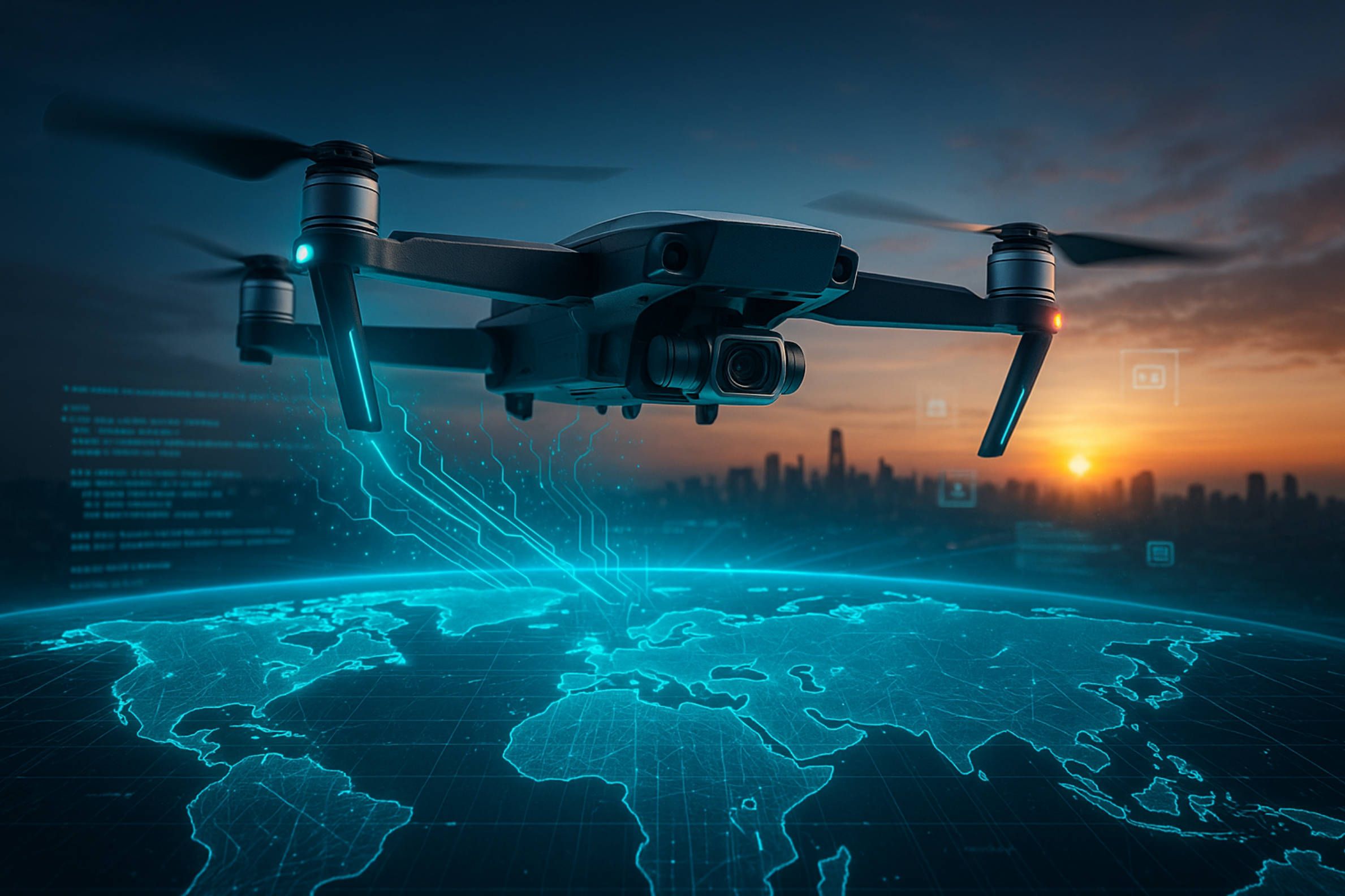
2.2 Mission Planner: from ground station to full‑stack lab
If ArduPilot is the engine, Mission Planner is the dashboard, diagnostic bay and racetrack rolled into one. The ground‑control application, written in C# but runnable under Mono and natively on Windows, has collected ≈ 6 900 commits and 1 900 GitHub stars over its decade of evolution GitHub. Operators often meet it first as a point‑and‑click interface: right‑click on the map, drop a sequence of waypoints, press “Write” and an aircraft obeys. Yet under the hood Mission Planner hides tools that rival high‑end avionics test benches.
Flight simulation: With a single menu selection, the program launches Software‑in‑the‑Loop (SITL) binaries compiled from the very same source tree destined for the flight controller. Developers tweak gains, inject GPS multipath errors or replay wind gusts, then iterate code without risking carbon‑fiber prototypes. For deeper verification, the package still exposes Hardware‑in‑the‑Loop hooks, letting a real autopilot board close the control loop against simulated physics.
Deep log analytics: Every flight can record more than a hundred sensor channels at up to 400 Hz. Mission Planner’s built‑in parser transforms gigabytes of binary data into time‑aligned plots, FFT spectra and automatic flagging of vibration, oscillation or compass interference. Regulatory auditors value such transparency; insurers increasingly require it.
Scriptable ground automation: An embedded IronPython console talks to the MAVLink bus in real time. A‑Bots.com engineers use this feature to push on‑the‑fly geofences, dynamic no‑fly corridors, or AI‑generated landing sites into active missions—capabilities impossible to replicate with closed consumer GCSs.
Because Mission Planner shares message definitions with ArduPilot, firmware customisations appear instantly in the ground station UI. That tight coupling removes weeks of interface work whenever a client asks for, say, a slider to control a novel gimbal or a dialogue for thermal‑camera calibration; A‑Bots.com simply adds a MAVLink parameter, recompiles, and Mission Planner renders the field automatically.
2.3 Extensibility, assurance & commercial readiness
Open code is only an advantage if it bends without breaking, and ArduPilot was designed for surgical modification. The project’s modular architecture isolates attitude controllers, navigation modes and peripheral drivers behind well‑documented interfaces. A‑Bots.com exploits that granularity to graft industry‑specific modules—precision‑sprayer flow control for agriculture, LTE fallback links for long‑range inspection, edge‑AI obstacle detection for urban deliveries—while leaving the safety‑critical core untouched and upstream‑compatible.
Integration doesn’t stop at the autopilot board. Both ArduPilot and Mission Planner speak MAVLink, a message bus capable of addressing up to 255 independent systems on a single network—enough headroom for multi‑drone swarms plus multiple ground stations and relay nodes mavlink.io. For enterprise clients that means one protocol covers the lone mapping aircraft they fly today and the fifty‑drone inventory they plan for 2028, without forklift upgrades to radios or software.
Assurance is the last, and perhaps most decisive, pillar. Regulators scrutinise autonomy far more than conventional piloted aircraft because the human fallback is gone. ArduPilot publishes every line of flight logic, enabling independent code audit. Mission Planner packages exhaustive post‑mission evidence: GPS noise statistics, EKF health flags, battery sag curves, barometric drift. Paired with SITL regression scripts that rerun entire flights at 10× speed on a CI server, this toolkit arms A‑Bots.com with a hard‑proof dossier when a client files for a BVLOS waiver or an SORA risk assessment.
Taken together, these three ingredients—one versatile codebase, an all‑in‑one ground station, and a provably extensible, verifiable integration layer—form the technical backbone of A‑Bots.com’s commercial offering. Clients gain a flight stack that matures weekly via global open‑source contributions yet remains fully customisable to niche missions; they gain tooling that compresses development cycles from months to days; and they gain a compliance pathway already trusted by thousands of operators worldwide. The next part of this long‑read will translate those technical strengths into business outcomes, illustrating how bespoke firmware, safety cases and support agreements turn capabilities into profit.
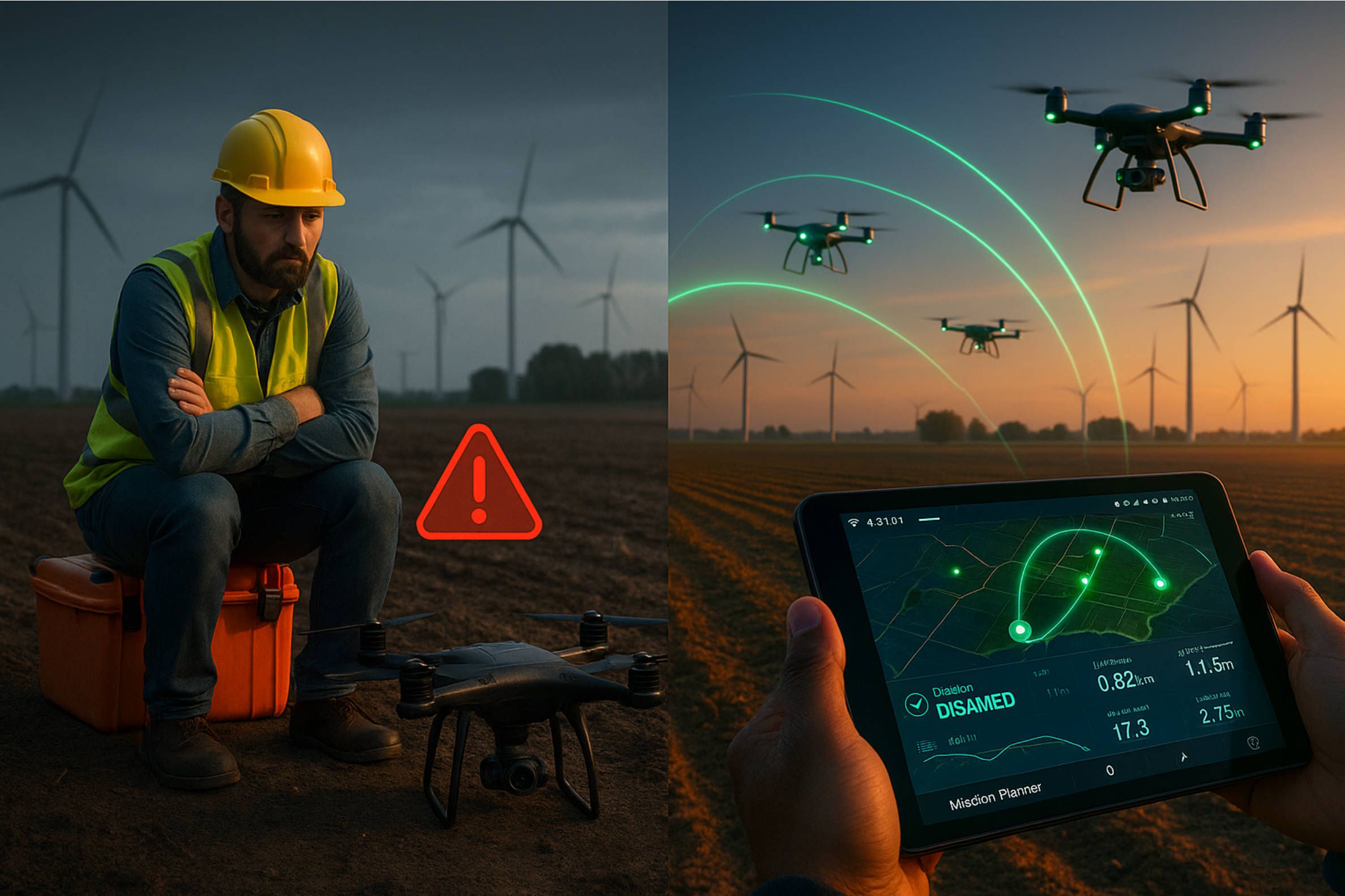
3 A‑Bots.com Value Proposition: Converting Mastery into Client Results
3.1 Strategic Firmware Craftsmanship & Rapid Prototyping
The first promise A‑Bots.com makes to a prospective OEM or enterprise operator is time. Most commercial‑grade drones spend nine to twelve months in iterative flight‑testing because control software lags behind airframe delivery; with ArduPilot and Mission Planner already living inside the company’s continuous‑integration pipeline, the median concept‑to‑air milestone shrinks to six weeks. The secret is disciplined firmware cut‑points. Rather than forking ArduPilot wholesale, A‑Bots.com isolates new functionality—terrain‑following modes for linear‑infrastructure mapping, LTE relay fall‑backs for offshore inspection, or edge‑AI waypoint triggers for wildlife surveys—inside loadable modules. Core flight logic remains untouched and can absorb upstream security patches the moment they land, eliminating the painful re‑base cycles that plague proprietary stacks.
Speed, however, is only compelling if the resulting behaviour is rock‑solid. Here Mission Planner becomes more than a ground station; it is the test harness that proves each line of code earns its place in the air. A‑Bots.com runs every pull request through Software‑in‑the‑Loop re‑enactments of real flights, replaying logged atmospheric turbulence, GPS drop‑outs and payload power surges harvested from thousands of earlier missions. Hardware‑in‑the‑Loop gates follow, with the exact autopilot board and sensor suite that will ship to the customer. The outcome is a flight envelope defined not by anecdotal “it worked in the field” confidence but by deterministic pass‑fail metrics: stable attitude within ± 2 degrees under 25‑knot gusts, mission‑time deviation under 0.8 percent across battery chemistries, navigation accuracy under ten centimetres in RTK mode.
These numbers translate into operational wins. A wind‑turbine inspector in the North Sea commissioned A‑Bots.com to replace its vendor‑locked autopilot because sudden Atlantic squalls were forcing manual aborts; after integrating gust‑adaptive PID tables and predictive landing selection, the client cut unplanned return‑to‑home events by 42 percent in the first quarter and documented a two‑hour daily productivity gain per crew. A surveying firm in the Canadian prairies asked for an extreme‑density waypoint scheduler to capture quarter‑inch elevation deltas; by streaming waypoint updates mid‑flight via IronPython scripts, the firm finished 500‑acre orthomosaics in a single battery cycle and eliminated the need for helicopter spot‑checks. Such examples might differ in geography and payload, yet they share a narrative: firmware mastery, wielded surgically, lets clients squeeze more missions into the same airframe and regulatory clock.
A‑Bots.com’s engineering culture is deliberately transparent. Every engagement begins with a design review that leaves the client holding annotated UML diagrams, SITL test suites and a parameter‑lock spreadsheet mapping each risk to a mitigation. Whether the drone ends up carrying a hyperspectral camera, a LiDAR pod or a swarm relay beacon, the customer owns a repository of proof that the machine will do exactly what a regulator, insurer and finance team expect. This paper trail is not window dressing; it is the artifact that earns faster BVLOS approvals and more favourable hull‑loss premiums, advantages no hardware redesign alone can secure.
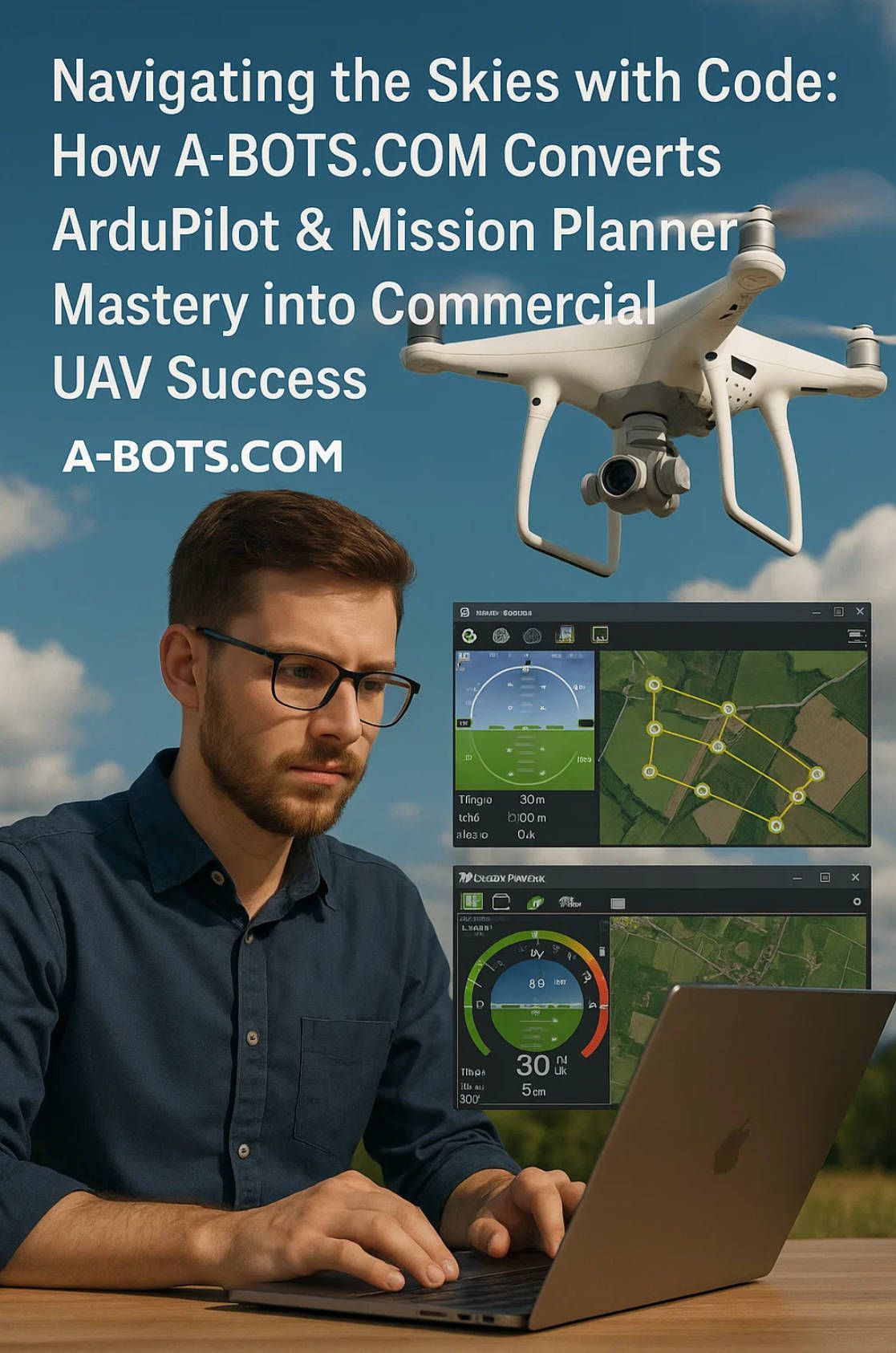
3.2 Engagement Frameworks & Demonstrated Impact
Once the technical edge is established, value crystallises through business models tailored to how drone programmes evolve. Start‑ups and research labs typically choose the Prototype Sprint: a six‑week, fixed‑price package that delivers a reflashed autopilot, ground‑station profiles, and simulated safety‑case evidence good enough for controlled‑airspace demonstrations. The sprint often serves as the bridge between a technical‑proof round of funding and a Series A road‑show, because investors can watch live telemetry and simulation replays instead of slides.
Mature operators gravitate toward the Modular License. Here, A‑Bots.com maintains a private ArduPilot fork in which certified modules—geo‑caging with live NOTAM ingestion, redundant communication blend‑overs between 900 MHz and 4G, obstacle‑prediction hooks for AI co‑processors—live behind feature flags. License terms allow the client to deploy an unlimited number of airframes while A‑Bots.com pushes continuous security updates, regression‑tested against both vanilla upstream and each custom extension. The commercial result is a predictable annual fee that CFOs can amortise, rather than cap‑ex spikes tied to hardware refreshes.
For fleet operators whose drones are already in service but need to unlock new revenue, the firm offers the Data‑Backed Optimisation Retainer. Engineers ingest flight logs, maintenance records and mission profitability reports, then correlate vibration signatures, throttle curves and battery impedance with unplanned downtime and service‑level penalties. Firmware tweaks follow: refined notch filters, dynamic current limits, adaptive cruise speeds that respect battery health. One logistics customer operating medical‑supply drones in East Africa saw flight‑hour utilisation rise 35 percent and consumable spend drop 18 percent within six months—gains attributed not to new aircraft but to code and analytics delivered over the air.
Across all engagement models, A‑Bots.com aligns incentives with client success by structuring milestone payments on measurable outcomes: flight hours without incident, regulatory approvals secured, mission duration shortened, data resolution improved. This contrasts with traditional systems‑integrator contracts that pay for effort rather than effect. Because ArduPilot remains open and Mission Planner logs every second of telemetry, both parties can audit the scoreboard. When a corridor‑inspection drone documented a 70‑percent reduction in man‑hours compared with helicopter surveys, the savings figure arrived via CSV export straight from the ground station—no marketing spin required.
Beyond financial metrics lies reputational capital. Regulators remember airframes that submit impeccable logs; insurers track carriers with downward accident curves. Success stories therefore snowball: a BVLOS approval granted in Saskatchewan bolsters a waiver application in Queensland, which in turn shortens the review period in Saxony. Each flight that executes flawlessly, each dataset that proves risk mitigation, feeds the virtuous loop. A‑Bots.com’s customers ride that momentum because the codebase under their drones is never static; it evolves weekly alongside the upstream repository while retaining the bespoke extensions that differentiate them from the next operator in line.
Viewed through a commercial lens, mastery of ArduPilot and Mission Planner is not a technical résumé bullet point but a flywheel. It accelerates time‑to‑market, lowers compliance friction, unearths operational efficiencies, and ultimately turns drones into recurring‑revenue platforms rather than depreciating assets. The next and final section of this long‑read will look forward, mapping how swarm autonomy, AI‑driven navigation and satellite‑linked control channels will amplify those returns—and why embedding such capabilities today is the surest way to own the airspace tomorrow.

4 Future Horizons: AI Autonomy, Swarming & Multi‑Domain Operations
A‑Bots.com’s roadmap does not end with today’s flight envelopes. The same open architecture that underpins ArduPilot and Mission Planner gives the company a launchpad for the next decade of aviation—one in which onboard intelligence, collaborative airframes and cross‑domain fleets transform drones from isolated sensors into adaptive, networked robots. Four vectors of innovation are already shaping the work under way in our R&D hangar.
4.1 AI‑Augmented Navigation: from scripted paths to situational thinkers
The classical autopilot is deterministic: it follows pre‑planned waypoints, checks altitude gates, obeys a set of hard‑coded failsafes. That rigidity keeps regulators happy, yet it leaves value on the table whenever conditions change faster than a human can replan. Enter edge machine learning. Today’s inference modules—NVIDIA Jetson Orins, Hailo‑8, Qualcomm RB5—can run object detection, semantic segmentation and reinforcement‑learning policies at single‑digit watts. When married to ArduPilot’s companion‑computer bus, they pull real‑time perception straight into the control loop: tree‑line avoidance in forestry surveys, adaptive approach vectors in high‑rise façade inspections, even terrain‑following for nap‑of‑the‑earth cargo flights where GNSS is unreliable.
A‑Bots.com integrates these capabilities through a three‑layer stack. The perception layer runs TensorRT‑optimised models trained on domain‑specific datasets—corroded tower struts, soybean canopy gaps, migratory‑bird silhouettes. Detected features are distilled into MAVLink VISION_POSITION_DELTA and OBSTACLE_DISTANCE messages, which the guidance layer converts into velocity constraints or micro‑waypoint insertions. Finally, an arbitration layer weighs AI suggestions against mission priorities and regulatory ceilings. Because the arbitration module resides in a loadable ArduPilot component, clients can certify its behaviour independently without exposing proprietary model weights.
The commercial pay‑off is twofold. First, data quality spikes. A photogrammetry drone that nudges its gimbal orbits to maintain sun angle produces orthomosaics with fewer shadow artefacts, cutting post‑processing time by half. Second, sortie economics improve. Offshore‑inspection contracts penalise aborted missions; a vision‑guided landing routine that threads between ship masts under Beaufort‑six winds saves tens of thousands in vessel repositioning fees. While competitors wait for closed‑source vendors to roll out generic “AI mode,” A‑Bots.com customers field task‑trained autonomy that speaks the same Mission Planner dialect they already audit today.
4.2 Scalable Swarm Control: many aircraft, one evolving brain
Single aircraft deliver insight; swarms deliver throughput. Agriculture offers the clearest example: covering ten thousand acres during a narrow spraying window would require unworkable battery swaps if flown sequentially, but a dozen smaller copters operating in parallel can finish before dawn dew lifts. Swarm benefits extend to logistics (mesh‑hopping parcels), search‑and‑rescue (distributed thermal imaging) and cinematography (dynamic multi‑angle coverage).
ArduPilot and MAVLink lay the technical groundwork for swarms by supporting 255 system IDs on one network, time‑stamped message queues and heartbeat synchronisation. A‑Bots.com pushes this foundation further with a coordination service that runs on a lightweight Kubernetes cluster—on‑prem for security‑sensitive clients, or cloud‑hosted for rapid scaling. Each aircraft publishes its state vector at 20 Hz; the coordinator resolves conflicts, updates shared maps, and issues deconflicted velocity sets. Critically, all traffic flows through standard MAVLink envelopes, so existing ground stations can observe and auditors can replay events without new tooling.
Swarm safety hinges on latency and redundancy. Our engineering team therefore builds dual‑path radios—sub‑GHz LoRa for command resilience, 5G NTN for high‑bandwidth telemetry. If both links fail, every drone carries a failsafe that converts the most recent swarm plan into an independent loiter‑then‑RTK‑land routine. In field trials over Spanish olive groves, a 20‑copter swarm lost two K‑band back‑hauls when terrain blocked line of sight; the remaining aircraft self‑adjusted sector assignments in under twelve milliseconds, finished coverage within the original time budget and landed with battery reserve to spare.
The value proposition is simple arithmetic: if one aircraft maps two square kilometres per hour, a swarm of twenty maps forty—with no additional pilots and only marginal uplink bandwidth. Clients often discover that the bottleneck moves from flight time to cloud‑processing queues, a problem easier to solve with GPU hours than with ground crews and fuel.
4.3 Regulatory & Market Outlook 2030‑2034: from waiver culture to performance‑based corridors
Regulation today revolves around concessions: operators petition agencies for BVLOS waivers, night‑flight exemptions, or population‑density relief. By 2030 policy will flip. In the United States, the forthcoming Part 108 framework is expected to end one‑off waivers in favour of performance‑based requirements—detect‑and‑avoid range, command‑link probability of loss, and hazard concentricity metrics derived from the ASTM F38 standard. Europe’s U‑space architecture already outlines corridors where approved drones fly autonomously under service‑based air‑traffic management, and Transport Canada is drafting a similar BVLOS framework synchronised with NASA’s UTM increments.
This shift rewards operators who can produce quantitative safety evidence on demand. Mission Planner’s log channels, which already record IMU health flags and EKF variances, will soon feed directly into real‑time conformance monitors that stream hashed telemetry to oversight servers. A‑Bots.com is contributing code to embed cryptographic signatures in MAVLink headers, ensuring provenance for black‑box regulators without exposing proprietary payload data. When corridors open, the flight software that passes muster will be systems whose audit hooks were designed years earlier—not retrofitted after notices of violation.
Market analysts see a corresponding jump in addressable revenue. Once corridor operations unlock cross‑city delivery and 24‑hour inspection cycles, drone services could top USD 300 billion in annual spend by 2032, dwarfing today’s numbers. Edge‑computing vendors and 5G carriers are positioning for a slice, but they still need an autopilot that proves every decision. By embedding compliance primitives at the firmware level, A‑Bots.com creates an on‑ramp that hardware manufacturers and service providers can license rather than build from scratch.
4.4 Strategic Partnerships & R&D Roadmap: beyond airframes to symbiotic fleets
Looking forward, autonomy will not stop at the shoreline or the warehouse door. Environmental monitoring missions already pair fixed‑wing drones for macro‑sampling with surface vessels that collect water chemistry and rovers that navigate riverbanks to deploy sensor pods. Because ArduPilot’s codebase covers plane, copter, boat, rover and submarine modes, A‑Bots.com can orchestrate these heterogeneous fleets under one command schema. A wildfire‑response concept underway with a West Coast utility demonstrates the synergy: VTOL aircraft launch from a staging area, map infrared hotspots, and drop markers; ground rovers equipped with LiDAR confirm burn‑line integrity, while tethered multicopters maintain radio mesh for firefighters. All vehicles share state over a unified swarm bus, reducing command overhead and enabling situational awareness on a single Mission Planner console.
Achieving such multi‑domain choreography requires a hardware pipeline as modular as the software. Our partnership program therefore aligns with open‑hardware consortia—Pixhawk for flight controllers, Blue Robotics for marine thrusters—and semiconductor vendors shipping neural‑network accelerators small enough for sub‑kilo airframes. A‑Bots.com contributes reference‑design carrier boards that expose time‑synchronised PPS outputs, deterministic SPI busses for LiDAR timing, and USB‑C PD negotiation for hot‑swappable payloads. Early adopters in precision‑ag and maritime survey have begun shipping products built on these designs, shortening their supply‑chain risk and accelerating certifications that now accept “Pixhawk ecosystem” as a known entity.
The R&D roadmap projects three milestone deliveries. Horizon One (12 months) finalises a containerised autopilot runtime that lets operators roll back firmware versions in flight, akin to blue‑green deployments in DevOps. Horizon Two (24 months) introduces satellite‑link resilience built on LEO constellations; field tests with Iridium Certus and Starlink reveal sub‑350‑millisecond round‑trip times, enough for supervisory commands even mid‑Pacific. Horizon Three (36 months) targets a shared autonomy bus where AI behaviours—swarm allocation, obstacle classification, dynamic re‑routing—compile to WebAssembly and hot‑load onto any vehicle that satisfies resource manifests, turning drones and ground robots into interchangeable nodes in a distributed compute fabric.
These milestones are not speculative wish‑lists; each one is anchored by funded customer pilots whose contractual success metrics cascade into the core open‑source repository once proprietary layers are stripped. The relationship is symbiotic: clients obtain first‑mover differentiation, the community gains hardened code, and A‑Bots.com sustains a feedback loop of production hours that reveal edge‑case bugs before they hit mass deployment.
In sum, the horizon for autonomous, multi‑domain fleets is expanding faster than most forecasts dared predict five years ago. The intuition that drones would become data utilities was correct; what surprises newcomers is the velocity with which software—not carbon fibre—sets the limits. Because A‑Bots.com planted its flag in ArduPilot and Mission Planner early, it now sits at the nexus of open‑source velocity, regulatory engagement and commercial urgency. The firm’s roadmap blends academic‑grade research, enterprise‑grade reliability and operator‑grade pragmatism, ensuring that when a customer asks, “Can we fly twenty drones over the Arctic, deploy a boat to sample meltwater, and land them all on a moving helipad?” the answer is not a shrug but a Gantt chart.
That confidence is the ultimate value: a future where autonomy decisions remain open, verifiable and yours to extend—and where A‑Bots.com stands ready to turn the next bold mission into certified, revenue‑earning reality. Contact A-Bots mobile app developer.
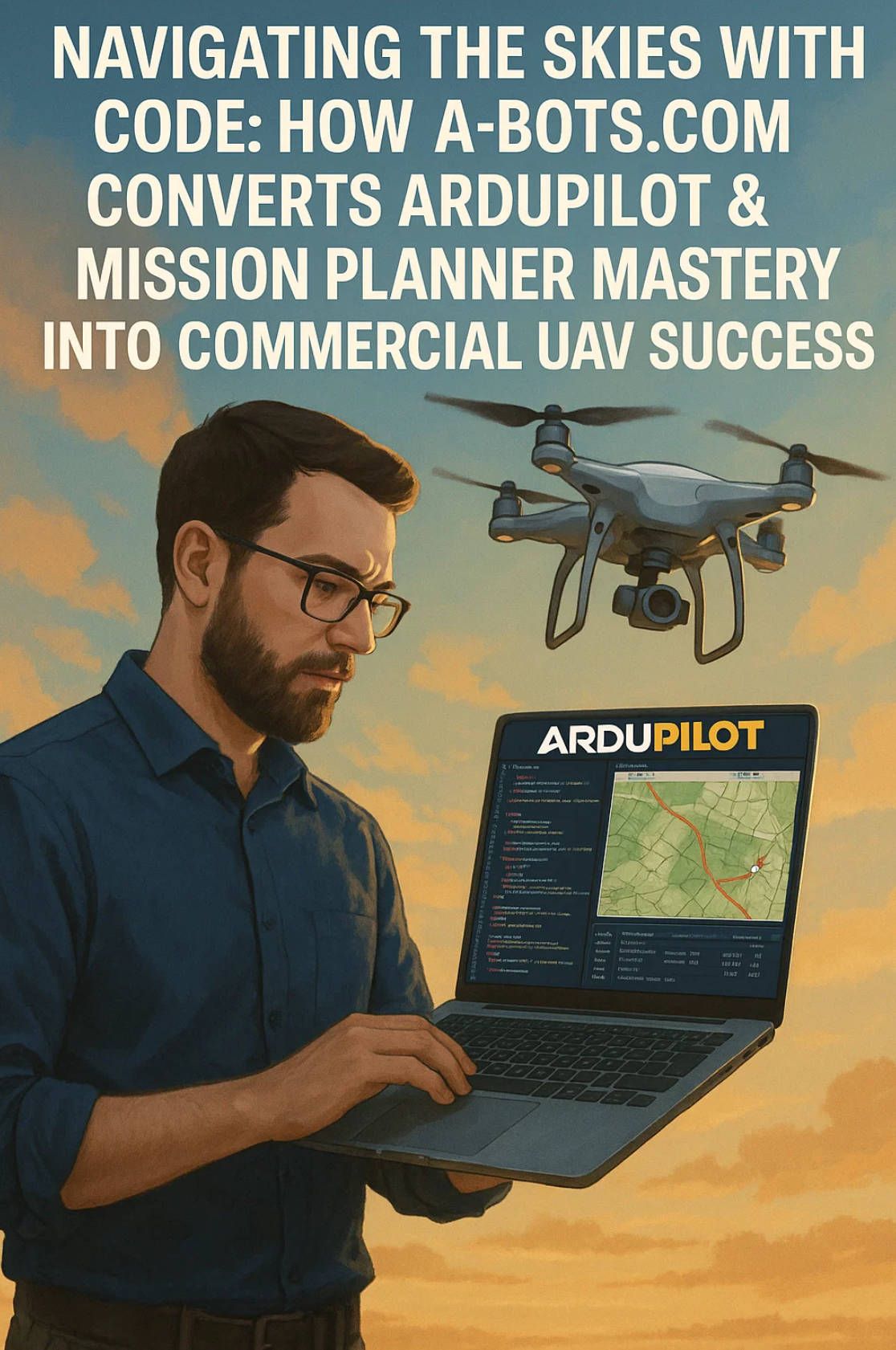
✅ Hashtags
#ArduPilot
#MissionPlanner
#DroneSoftware
#UAVDevelopment
#DroneAutonomy
#SwarmDrones
#AIinAviation
#BVLOS
Other articles
Augmented-Reality Maintenance Apps for Cobots Industrial cobots are the future of automation, but servicing them efficiently remains a challenge. This article explores how Augmented-Reality maintenance apps, powered by IoT and AI integration, dramatically reduce downtime, costs, and errors. Discover real-world case studies, data-driven insights, and why partnering with A-Bots.com can future-proof your maintenance operations with cutting-edge AR solutions.
Smart Solar and Battery Storage App Solar panels and batteries are cheaper than ever, but real value emerges only when software choreographs them minute by minute. This in-depth article tracks the cost curves reshaping residential energy, explains the app architecture that forecasts, optimises and secures every dispatch, and unpacks the grid-service markets that now pay households for flexibility. Packed with field data—from NREL bill-savings trials to Tesla’s 100 000-home virtual power plant—it quantifies user ROI across savings, resilience and sustainability. The final section details why A-Bots.com is uniquely positioned to deliver such platforms, fusing AI forecasting, IEC-grade cybersecurity and award-winning UX into a turnkey solution. Whether you build hardware, aggregate DERs or own a solar roof, discover how intelligence—not silicon—unlocks the next decade of energy value.
Custom App Development for Smart Hydroponic Gardens Controlled-environment agriculture is booming, yet success hinges on software that can orchestrate pumps, LEDs, nutrients, and climate in real time. In this in-depth guide A-Bots.com walks you through the full technology stack—hardware, edge intelligence, secure connectivity, cloud analytics, and UX—showing how each layer compounds into measurable savings. You’ll see case data on 90 % water reduction, 20 % yield gains, and pay-back periods as short as 26 months, plus a four-stage methodology that de-risks everything from proof-of-concept to fleet-scale OTA updates. Whether you’re a rooftop startup or an appliance manufacturer, learn how bespoke app development transforms a hydroponic rack into a transparent, investor-ready food engine—and why the next billion city dwellers will eat produce grown by code.
App Development for Elder-Care The world is aging faster than care workforces can grow. This long-read explains why fall-detection wearables, connected pill dispensers, conversational interfaces and social robots are no longer stand-alone gadgets but vital nodes in an integrated elder-safety network. Drawing on market stats, clinical trials and real-world pilots, we show how A-Bots.com stitches these modalities together through a HIPAA-compliant mobile platform that delivers real-time risk scores, family peace of mind and senior-friendly design. Perfect for device makers, healthcare providers and insurers seeking a turnkey path to scalable, human-centric aging-in-place solutions.
Offline AI Agent for Everyone A-Bots.com is about to unplug AI from the cloud. Our upcoming solar-ready mini-computer runs large language and vision models entirely on device, pairs with any phone over Wi-Fi, and survives on a power bank. Pre-orders open soon—edge intelligence has never been this independent.
Top stories
Copyright © Alpha Systems LTD All rights reserved.
Made with ❤️ by A-BOTS
